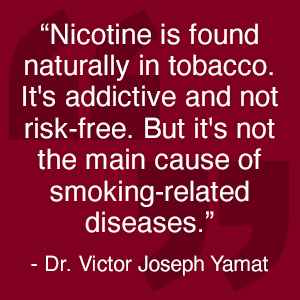Science has shown that burning or the combustion process when smoking a cigarette is what produces harmful constituents that cause disease, not nicotine.

This was the message that Dr. Victor Joseph Yamat, Scientific Affairs Manager of PMFTC, Inc., conveyed during the American Chamber of Commerce Business Innovation Forum 2021 dubbed “Redefining the Future” held online on June 10, 2021.
The local affiliate of Philip Morris International (PMI), PMFTC, Inc. participated in the virtual event along with experts of various fields to share insights on how businesses can leverage technological innovations to transform industries.

Yamat said nicotine, though not risk free is not the culprit. “Nicotine is found naturally in tobacco. It’s addictive and not risk-free. But it’s not the main cause of smoking-related diseases.” he revealed.
He noted that there are 16 million smokers in the Philippines now and the prevalence of smoking continues around the world.
“Despite the regulations imposed, it is estimated that by 2025, there will still be 1.1 billion smokers worldwide,” he said, citing the estimates of the World Health Organization.
Yamat said, “our best opportunity to contribute to positive change is clear: we need to innovate and innovate responsibly.”
Yamat was referring to PMI’s earlier pronouncement of “Delivering a smoke-free future.” He said this corporate vision has a very specific goal: to provide the world’s adult smokers, who would otherwise continue to smoke, with smoke-free alternatives.
“Scientific evidence has shown that burning is indeed the main problem. The reality is the moment we light anything on fire we practically open up a chemical factory. This applies to the tobacco in a cigarette. The fuel in a car. Or the wood in a stove. Studies have shown that as the temperature of tobacco increases, the levels of harmful chemicals being formed also increases. The onset of combustion is actually at around 400 degrees Celsius. This is why there is a movement across sectors to reduce and eliminate combustion or burning in the equation,” he said.
For PMI, Yamat said, “This means replacing cigarettes in the markets in which we operate with smoke-free alternatives. While not risk-free, these products are a far better choice than continued smoking.”
Since 2008, PMI has invested US$8.1 billion into Research and Development, which is 99 percent of the company’s total R&D expenditure. “We support an R&D team of 934 scientists, engineers, and technicians. We have 1,300 patents granted for our smoke-free technologies, and we have over 350 peer-reviewed studies,” he said.
This, according to Yamat, is a testament to PMI’s commitment to put science at the forefront as the company continues its quest.
“At PMI, we believe that responsible innovation through science and data results in solutions that benefit our consumers,” he said.
Differentiating smoke-free alternatives and cigarettes, Yamat said smoke-free alternatives are exactly what it says on the name – they don’t burn tobacco. They don’t create smoke and they only produce vapor and has no ash. On the other hand, cigarettes burn tobacco and produces smoke and ash.
Examples of smoke-free products are heated tobacco products (HTPs) and vapes or e-cigarettes.
HTPs like PMI’s IQOS heats real tobacco without burning it. Nicotine is naturally present in the tobacco. Meanwhile, e-cigarettes vaporize e-liquid. Vapes doesn’t have real tobacco, and the nicotine in it is derived from tobacco that’s added in the e-liquid. Both HTPs and vapes do not produce ash or smoke.
Yamat, however, clarified that smoke-free products are not risk-free and are addictive. “They are only for adult smokers who do not want to quit and who would otherwise continue smoking. And let me reiterate that the best choice a smoker can make is to quit cigarettes and Nicotine entirely.” Yamat said.
Internal researches by PMI showed a positive change in markets where IQOS is available to adult consumers.
“As of December 31, 2020, we estimate that there were close to 18 million IQOS users, of which 72 percent—or nearly 13 million—had switched to IQOS and stopped smoking, with the remainder in various stages of conversion,” Yamat said.
“Cigarette volumes declined in markets where we’ve introduced IQOS such as in Japan, where the rate of decline in cigarette sales increased five-fold following the introduction of our smoke-free product, according to a study by the American Cancer Society,” he said.
Yamat said they consider nicotine as the key to accelerating the end of smoking. “It’s difficult to envision how a world without cigarettes can be achieved in a timely manner without non-combustible alternatives. Education about what nicotine is – and what it is not – is required to accelerate innovation and progress.”
“With this, we’re hoping that we’ll be able to help the 16 million smokers in the Philippines. And we’re happy to note that there are 1 million Filipinos already using smoke-free alternatives,” he said.




















1 Comment
Keep this going please, great job!